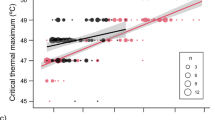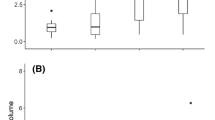Abstract
Extreme temperatures can constrain foraging behavior, and individual differences in thermal tolerances may affect foraging performance within and among species. Ambient temperatures may thus mediate competitive interactions among species that share resources. Different species of desert seed-harvesting ants (genus Messor) forage for similar food resources, and colonies can overlap in foraging areas. Because Messor species differ in body size distributions, and thermal tolerance is often size related in ants, we hypothesized that body size differences within and between Messor species would predict individual variation in worker thermal tolerances. Body size effects on thermal physiology could have implications for interspecific competition. We measured tolerances of extreme high (maximum critical temperature or CTmax) and low temperatures (CTmin) in two Messor species simultaneously at the same study site, smaller bodied M. ebeninus and larger bodied M. arenarius. Although the species did not differ significantly in CTmin or CTmax, tolerance of high temperatures was significantly size dependent for M. ebeninus: worker tolerances of high temperatures decreased with body size in this species. The patterns suggest the foraging activity of the smallest workers of smaller bodied species could be more constrained by high ambient temperatures, which could impact the division of labor within colonies as well as interspecific interactions.


Similar content being viewed by others
References
Avgar T (2007) Linking foraging traits of seed-eating ants to spatial patterns of surviving seeds. MS thesis, The Hebrew University of Jerusalem, Jerusalem
Avgar T, Giladi I, Nathan R (2008) Linking traits of foraging animals to spatial patterns of plants: social and solitary ants generate opposing patterns of surviving seeds. Ecol Lett 11:224–234
Baudier KM, O'Donnell S (2017) Weak links: how colonies counter the social costs of individual variation in thermal physiology. Current Opinion in Insect Science 22:85–91
Baudier KM, O'Donnell S (2018) Complex worker subcaste differences in thermal tolerances in the army ant Eciton burchellii parvispinum. J Therm Biol 77:278–280
Baudier KM, O’Donnell S (2020) Rain shadow effects predict population differences in thermal tolerance of leaf-cutting ant workers (Atta cephalotes). Biotropica 52:113–119
Bishop TR, Robertson MP, Rensburg BJ, Parr CL (2016) Coping with the cold: minimum temperatures and thermal tolerances dominate the ecology of mountain ants. Ecological Entomology 42:105–114
Bujan J, Kaspari M (2017) Nutrition modifies critical thermal maximum of a dominant canopy ant. J Insect Physiol 102:1–6
Bujan J, Roeder KA, Yanoviak SP, Kaspari M (2020) Seasonal plasticity of thermal tolerance in ants. Ecology 101:e03051
Cerda X, Retana J (1994) Food Exploitation Patterns of two sympatric seed-harvesting ants Messor bouvieri (Bond) and Messor capitatus (Latr) (Hym, Formicidae) from Spain. J Appl Entomol 117:268–277
Cerda X, Retana J (1997) Links between worker polymorphism and thermal biology in a thermophilic ant species. Oikos 78:467–474
Cros S, Cerda X, Retana J (1997) Spatial and temporal variations in the activity patterns of Mediterranean ant communities. Ecoscience 4:269–278
Diamond SE, Nichols LM, McCoy N, Hirsch C, Pelini SL, Sanders NJ, Ellison AM, Gotelli NJ, Dunn RR (2012) A physiological trait-based approach to predicting the responses of species to experimental climate warming. Ecology 93:2305–2312
Hoffmann AA, Chown SL, Clusella-Trullas S (2013) Upper thermal limits in terrestrial ectotherms: how constrained are they? Funct Ecol 27:934–949
Kaspari M, Clay NA, Lucas J, Yanoviak SP, Kay A (2015) Thermal adaptation generates a diversity of thermal limits in a rainforest ant community. Glob Change Biol 21:1092–1102
Kronfeld-Schor N, Dayan T (2003) Partitioning of time as an ecological resource. Annu Rev Ecol Evol Syst 34:153–181
Mesas A, Jaramillo A, Castañeda LE (2019) Correlated evolution between heat tolerance and thermal performance curves in Drosophila subobscura. BioRxiv, 864793. https://doi.org/10.1101/864793
Oberg EW, Toro I, Pelini SL (2012) Characterization of the thermal tolerances of forest ants of New England. Insectes Soc 59:167–174
Retana J, Cerda X (1994) Worker size polymorphism conditioning size matching in two sympatric seed-harvesting ants. Oikos 71:261–266
Ribeiro PL, Camacho A, Navas CA (2012) Considerations for assessing maximum critical temperatures in small ectothermic animals: insights from leaf-cutting ants. PLoS ONE 7:e32083
Saar M, Eyer PA, Kilon-Kallner T, Hefetz A, Scharf I (2018a) Within-colony genetic diversity differentially affects foraging, nest maintenance, and aggression in two species of harvester ants. Scientific Reports 8:1–12
Saar M, Subach A, Reato I, Liber T, Pruitt JN, Scharf I (2018b) Consistent differences in foraging behavior in 2 sympatric harvester ant species may facilitate coexistence. Current Zoology 64:653–661
Segev U, Ziv Y (2012) Consequences of behavioral vs. numerical dominance on foraging activity of desert seed-eating ants. Behav Ecol Sociobiol 66:623–632
Segev U, Tielboerger K, Lubin Y, Kigel J (2014) Consequences of climate and body size on the foraging performance of seed-eating ants. Ecological Entomology 39:427–435
Sinclair BJ, Marshall KE, Sewell MA, Levesque DL, Willett CS, Slotsbo S, Dong Y, Harley CD, Marshall DJ, Helmuth BS, Huey RB (2016) Can we predict ectotherm responses to climate change using thermal performance curves and body temperatures? Ecol Lett 19:1372–1385
Steinberger Y, Leschner H, Shmida A (1991) Chaff piles of harvester ant (Messor spp.) nests in a desert ecosystem. Insectes Soc 38:241–250
Steinberger Y, Leschner H, Shmida A (1992) Activity pattern of harvester ants (Messor-Spp) in the Negev Desert ecosystem. J Arid Environ 23:169–176
Stevenson RD, Peterson CR, Tsuji JS (1985) The thermal dependence of locomotion, tongue flicking, digestion, and oxygen consumption in the wandering garter snake. Physiological Zoology 58:46–57
Terblanche JS (2014) Physiological performance of field-released insects. Current Opinion in Insect Science 4:60–66
Traniello JFA (1989) Foraging strategies of ants. Annu Rev Entomol 34:191–210
Verble-Pearson RM, Gifford ME, Yanoviak SP (2015) Variation in thermal tolerance of North American ants. J Therm Biol 48:65–68
Warburg I, Steinberger Y (1997) On the spatial distribution of nests of the ants Messor arenarius and Messor ebeninus. J Arid Environ 36:671–676
Wendt CFR, Verble-Pearson RM (2016) Critical thermal maxima and body size positively correlate in red imported fire ants, Solenopsis invicta. The Southwestern Naturalist 61:79–83
Wills BD, Powell S, Rivera MD, Suarez AV (2018) Correlates and consequences of worker polymorphism in ants. Annu Rev Entomol 63:575–598
Acknowledgements
Funding was provided by a Drexel University Stein Family Fellowship (to S. O’D.). This is publication no. 1086 of the Mitrani Department of Desert Ecology.
Author information
Authors and Affiliations
Corresponding author
Electronic supplementary material
Below is the link to the electronic supplementary material.
Rights and permissions
About this article
Cite this article
O’Donnell, S., Bulova, S., Caponera, V. et al. Species differ in worker body size effects on critical thermal limits in seed-harvesting desert ants (Messor ebeninus and M. arenarius). Insect. Soc. 67, 473–479 (2020). https://doi.org/10.1007/s00040-020-00782-5
Received:
Revised:
Accepted:
Published:
Issue Date:
DOI: https://doi.org/10.1007/s00040-020-00782-5




